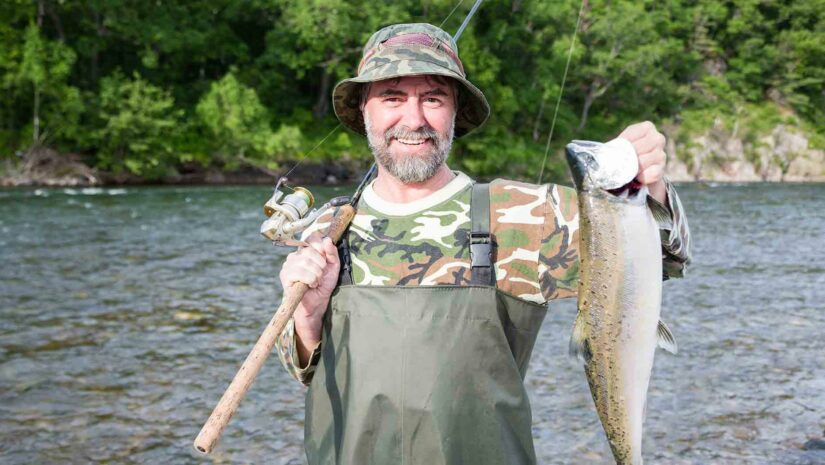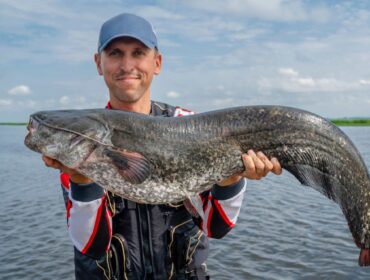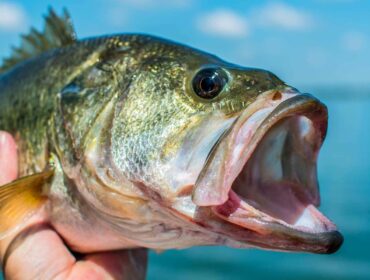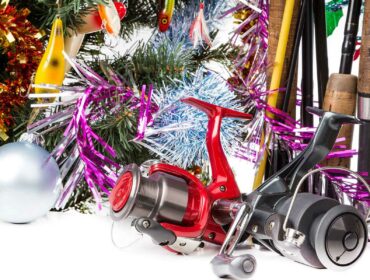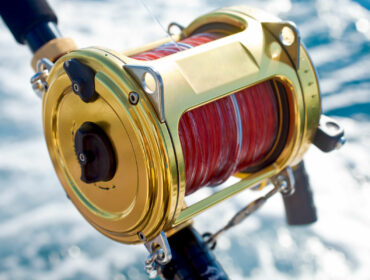Salmon is a popular fish that’s known all around the world for its versatile flavor and nutritional value. It is the third most commonly consumed seafood in the United States, after shrimp and canned tuna. This type of fish can be expensive when bought or ordered in restaurants, so why not try to catch it yourself?
But to catch this popular game fish fresh from the stream, you’ll need a lot of patience and the right fishing gear. You’ll also need to be knowledgeable about the best salmon fishing techniques and the underwater behavior of salmon.
Tips for Catching Salmon

While we are no experts in giving concrete and professional fishing advice, we’ve put together a set of tips to serve as a great starting point for novice and experienced fishers interested in salmon fishing.
Learn More About Salmon
Before you head to the water, it’s always best to find as much necessary information as possible about your catch. For example, they can live in fresh and saltwater.
Salmon are anadromous, meaning they are born in freshwater rivers and streams and then migrate to the ocean, where they spend much of their existence throughout adulthood. Eventually, they return to the freshwater rivers and streams where they were born to reproduce. This means you can only catch them in specific areas where they do their “runs.”.
Although they are traditionally known to have vibrant pinkish-red flesh and shiny silver skin, the color of their insides varies depending on their diet, while their skin turns red when it’s time to spawn.
There are also six main species of salmon:
- Pink Salmon – Sometimes called “humpies” or humpback salmon for their distinctive back hump when they spawn; this common type of salmon is very light colored, flavorful, and has a low-fat content. It is primarily sold as a canned product.
- Sockeye Salmon – Referred to as the “reds” for their dark red flesh and skin that turns deep red when they spawn. The sockeye salmon is known for its deep, rich flavor and can be sold fresh, frozen, or canned.
- Atlantic Salmon – This species of salmon is commonly consumed in the United States and farm-raised in Canada, Chile, and Norway. However, commercial fishing for wild Atlantic salmon has been banned for their extremely low population levels along the Eastern Seaboard.
- Chum Salmon – Also called dog salmon for their canine-like teeth and ”Keta” (from its scientific name), chums are primarily harvested in Alaska. They are usually canned or sold to foreign markets. They’re typically small and have medium-colored flesh with lower fat content than other salmon types.
- Chinook Salmon – Also known as King salmon, it is considered the best tasting. It has a high fat content and rich flesh ranging from white to deep red.
- Coho Salmon – Often called “silvers” for their bright silver skin. Cohos have bright red flesh and feature a more delicate texture than the Chinook, although they share a similar flavor.
You’ll know that uncooked salmon is fresh if it has a mild ocean-like aroma, unlike the usual “fishy” smell when it spoils. Fresh salmon also has firm flesh that springs back when pressed.
Pick Your Location
Now that you know more about the types of salmon that you can catch (well, most of them), decide where you want to fish. Since they follow a specific migratory route, you must research runs, hatchery areas, dams, and other spawning locations. Also, consider checking out fishing holding areas and asking local fishing veterans where you can fish for your preferred type of salmon.
The key is to choose the proper river, water system, or lake to significantly increase your chances of getting a great Salmon catch. Aside from ensuring that your time and effort will not go to waste. You can also check out the following list of salmon fishing and search the areas:
- List of Recreational Salmon Fishing Areas
- Maps of Hatcheries and Dams (Pacific Northwest)
- Maps for Inland Trout and Salmon
You can also track salmon statistics listed by your local natural resources or fish and wildlife office online for conservation and management purposes and use it to find your ideal fishing location.
Once you’ve chosen your location, make sure you find out about their rules and regulations, as some could be catch-and-release areas that don’t allow you to bring your catch home.

Discover Salmon Fishing Techniques
Even if you know the basics of fishing, there’s much to learn beyond casting a fishing line. It’s essential to know the most effective salmon fishing methods. Depending on the kind of salmon you’re aiming for, how many of them you want to catch, and how many people you’re fishing with.
The easiest way is to fish from land because you won’t need a lot of equipment. An example is pier fishing, which can be very effective for catching big fall salmon between summer and fall when they move to shallower waters with cooler temperatures. However, the most common way anglers catch salmon is from a boat, as it allows them to get closer to where the game fish are.
Wherever you decide to fish from, you can choose between a handful of techniques categorized under drift fishing and trolling.
Drift Fishing
This technique is commonly executed with a strong water current and a higher concentration of salmon. It involves casting your line upstream from a stable spot and allowing your bait to drift down over an area where you think salmon are. As your line drifts, you slowly reel it in and prepare to repeat the process.
Its efficiency is the natural presentation of the moving bait to the target area. There are also more specific types of drift fishing, such as mooching, jigging, and fly fishing.
Trolling
Trolling is when you fish from a moving boat. Types of trolling include motor mooching, diver trolling, and downrigger trolling. All of these involve using unique accessories to present your bait at more specific depths. You also occasionally move your boat up and downstream, so you’re likelier to catch them while they move with the current. It’s ideal when fishing in areas where salmon are more spread out, such as in lakes.
You can use planer boards made of wood, plastic, or foam to use multiple lines and cover a larger area when trolling. However, the key to using planer boards is to ensure they correspond to the side of the boat where your fishing rods are and create varying angles so your lines don’t tangle in the water.
Other techniques include plunking, which uses a similar setup to drift fishing and can be done from shore or an anchored boat, and float fishing (also called bobber fishing). You can learn more about the many salmon fishing techniques here.

Get Your Stamp or Permit
Just as when you decide to go spearfishing or catch lobsters, you’ll need a unique stamp or permit. Aside from your fishing license, before you can see and keep salmon in the US, that is if you don’t want to be hit with a hefty fine or have your equipment removed. Don’t worry; the cost will help fund salmon stocking and conservation programs and contribute to the marine ecosystem’s health.
Choose Your Rod, Reel, and Line
Once you get your stamp or permit, you can gather your equipment. If you’re starting, don’t worry; we can help you shop for essential fishing gear. But for salmon fishing, you may want to already look for an 8.5 to 9 feet long fishing rod and a variety of fishing lines to suit your catch (for example, a 20-25 lb. line for Chinook salmon and 10-15 lb. for Pink Salmon). You may also need a non-corrosive reel for fishing in saltwater.
Use the Best Lures
One of the best methods for catching salmon is to use live bait (particularly with roe or fish egg sacks) during spawning season. You can buy this at tackle and bait shops or construct your own by harvesting them, mixing your cure, and constructing egg sacks. Ensure you don’t burst any eggs when attaching the egg sack to avoid decreasing their efficiency.
If you can’t stomach raw fish eggs, you can go the artificial route and purchase spinners like the Mepps Aglia or buy fake salmon eggs (sold separately as plastic beads) and tie them into a group near your hook.
Whatever you choose, make sure they have bright and catchy colors like red, fluorescent pink, fluorescent orange, or blue, with the shade depending on the current lighting condition.

Sharpen Your Hooks
Another thing that makes salmon fishing quite challenging is the fact that they have thick jaws. This means you’ll need razor-sharp hooks, or you’ll have a difficult catch with your line.
Only shop for high-quality hooks that don’t break, and keep a hook sharpener. Use it to sharpen the hook with quick strokes across each side up to the point while keeping it parallel to the shank. You can test the sharpness by drawing it across your thumbnail at a 45-degree angle. If it sticks instead of just sliding across, then it’s sharp enough.
Fill Up Your Tackle Box
With your most oversized equipment ready, it’s time to fill your fishing tackle box with everything you need. Of course, what you bring will have to depend on your game plan. Bring all the necessary equipment (like lures, bobbers, weights, and divers) that you’ll need for your preferred techniques. Including those you might want to try out later in the day.
Make sure you also have the following:
- Fishing license
- Tackle box (with extra line, fish stringers, bobbers, hooks, jigs, leaders, lures, sinkers, weights)
- Map of fishing location
- Compass
- Measuring tape (for checking size restrictions)
- Needle nose pliers
- First aid kit
- Insect repellent
- Sun protection
- Rain gear
- Snacks and water
Check Weather & Water Temperature Forecasts
Salmon are easiest caught during overcast days and in waters close to 55°F. So, check the forecast and consider fishing during dawn or dusk for best results.
But don’t worry—even if the clouds suddenly clear up while fishing, you’ll still have a good chance of catching salmon if you use a brighter lure at slightly greater depths. But on dark days, also use darker lures.
Store Your Catch
Once you’ve successfully caught salmon with your line, don’t celebrate just yet. To enjoy your catch, you’ll need to handle them carefully and store them properly.
First, don’t just let your salmon flop on the floor of your boat or shove them all straight into a catch bag, as this will soften and bruise their flesh. You’ll need to stun and clean the guts out of your salmon as soon as possible.
Next, keep the salmon cold by placing them in a cooler with ice as soon as possible to preserve their freshness. Change the ice as needed and keep them out of the water by draining water from the bottom of the cooler. If you don’t have ice, wrap each salmon loosely in a damp cloth or paper and place them in a shaded area.
Once a freezer becomes available, carefully vacuum seal your salmon to preserve its flavor and minimize the freezer burn and oxidation. This final step of the process can keep your catch fresh for up to several months if done correctly.

